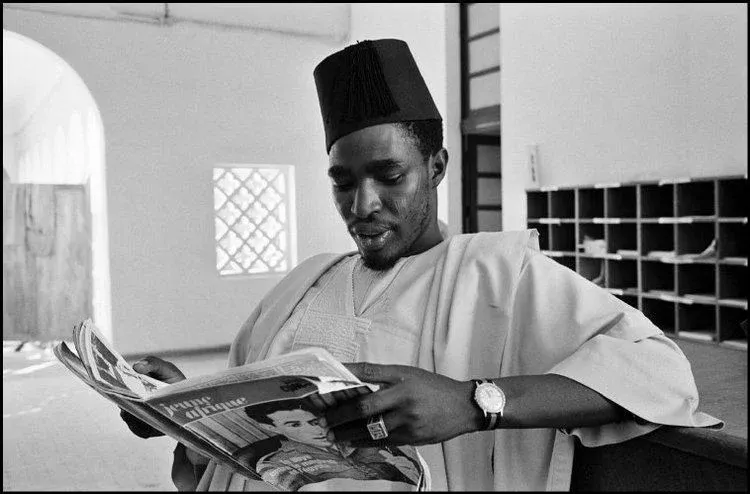 Imagine a world where the African equivalent of Walt Disney wasn’t an artist but a mechanic with a bold dream of creating cartoons. This is the incredible journey of Moustapha Alassane, the pioneering figure who ignited the animation scene in Africa. Hailing from Niger, Alassane transitioned from fixing cars to crafting legendary animated films that captured the essence of African life.
Imagine a world where the African equivalent of Walt Disney wasn’t an artist but a mechanic with a bold dream of creating cartoons. This is the incredible journey of Moustapha Alassane, the pioneering figure who ignited the animation scene in Africa. Hailing from Niger, Alassane transitioned from fixing cars to crafting legendary animated films that captured the essence of African life.
Born in 1942 in N’dou Gou, Niger, Alassane’s early aspirations didn’t revolve around animation. However, his passion for film drove him to enrol at the Institut de Formation Artistique de Niamey (IFAN), where he crossed paths with renowned French filmmaker Jean Rouch. Rouch recognised Alassane’s talent and took him under his wing, introducing him to the fascinating world of cinema.
Alassane’s journey took an exciting turn when Rouch facilitated his studies in Canada with the acclaimed animator Norman McLaren. Upon his return to Africa, Alassane was determined to make a lasting impact on the animation landscape.
 His cartoons transcended mere entertainment; they addressed pressing social issues. Alassane cleverly used animation to tackle themes such as politics and economics in Niger. His memorable characters, particularly those featuring frogs, resonated deeply with audiences and became cultural icons.
His cartoons transcended mere entertainment; they addressed pressing social issues. Alassane cleverly used animation to tackle themes such as politics and economics in Niger. His memorable characters, particularly those featuring frogs, resonated deeply with audiences and became cultural icons.
Alassane made his directorial debut in 1962 with the film “La Bague du roi Koda,“ followed by the adventurous “Le Retour d’un aventurier“ in 1966. His filmography includes significant works like “Bon Voyage Sim,” which critiqued African politics, and “FVVA: Femme, villa, voiture, argent,” released in 1972, which humorously examined materialism. In 1974, he created “Toula, ou Le genie des eaux,,” a folk tale rich with moral lessons.
Beyond filmmaking, Alassane dedicated 15 years to teaching aspiring filmmakers at the University of Niamey. His commitment to nurturing new talent earned him numerous accolades, including a prestigious award from the French president at the Cannes Film Festival in 2007.
Moustapha Alassane’s remarkable journey from car mechanic to animation pioneer illustrates that passion and opportunity can lead to extraordinary achievements. He revolutionised African animation, leaving behind a legacy that continues to inspire aspiring cartoonists today.
Who is the Father of African Animation?
Moustapha Alassane, often celebrated as the father of African animation, frequently featured toads and other animals in his work, using these characters as allegorical critiques of politics in Niger. His animations, characterised by simple line sketches set against monochrome backgrounds, broke new ground in storytelling and artistic expression across the continent.
Frequently Asked Questions
1. Why is Moustapha Alassane considered the father of African animation?
Moustapha Alassane is recognised as the father of African animation for his pioneering work in the field, creating some of the continent’s first animated films that addressed social and political issues relevant to African life. His ability to weave cultural narratives into animation serves as an inspiration for animators looking to tell their own stories.
2. What themes did Alassane explore in his animations?
Alassane’s animations often tackled serious topics such as politics, economics, and cultural identity in Africa, using humour and allegory to engage audiences and provoke thought. Aspiring 3D animators can learn the importance of meaningful storytelling and the power of animation to comment on social issues.
3. How did Alassane’s background influence his work in animation?
Initially trained as a mechanic, Alassane’s diverse experiences allowed him to approach storytelling with a unique perspective. Aspiring animators can take inspiration from his journey, understanding that varied life experiences can enrich their creative work and lead to innovative animation styles.
4. What notable films did Moustapha Alassane create?
Some of Alassane’s significant films include “La Bague du roi Koda,” “Le Retour d’un aventurier,” “Bon Voyage Sim,” and “FVVA: Femme, villa, voiture, argent.” Each of these works reflects his commitment to social commentary through animation, reminding aspiring animators to integrate personal and cultural narratives into their projects.
5. Did Moustapha Alassane have an impact on future generations of animators?
Yes, Alassane not only produced influential films but also spent years teaching filmmaking at the University of Niamey. His dedication to education emphasises the importance of mentoring and sharing knowledge, a valuable lesson for experienced animators looking to support the next generation of creators.
6. What recognition did Alassane receive for his contributions to film and animation?
Alassane received several awards throughout his career, including a notable recognition from the French president at the Cannes Film Festival in 2007. This highlights the importance of pursuing excellence and innovation in animation, motivating aspiring 3D animators to strive for recognition in their own work.
7. How can aspiring 3D animators learn from Moustapha Alassane’s work?
Aspiring animators can study Alassane’s films to understand how to blend art and social commentary effectively. They can also explore the significance of cultural storytelling, experiment with different animation styles, and embrace their unique perspectives to create compelling narratives in 3D animation.
8. What advice can aspiring animators take from Alassane’s journey?
Alassane’s journey from mechanic to animation pioneer illustrates that passion and opportunity can lead to extraordinary achievements. Aspiring animators should focus on honing their craft, seeking mentorship, and being open to new experiences that can inspire their work.
9. How can I learn more about Moustapha Alassane’s influence on animation?
To learn more about Moustapha Alassane, explore documentaries about African cinema, academic articles on animation, and online resources focusing on his films and their cultural impact. Engaging with communities of animators and attending film festivals can also provide valuable insights into his legacy and the broader animation landscape.
Next Steps: Engage with CGAfrica
1. Share Your Thoughts:
We’d love to hear your opinions on Moustapha Alassane’s work and its impact on African animation. Share your thoughts in the comments section below!
2. Explore More:
Dive deeper into the world of African animation. Check out our blog for more articles about influential figures, trends, and techniques in the animation industry.
3. Join the Conversation:
Connect with fellow animators and enthusiasts in our online community. Share your work, ask questions, and collaborate on projects that celebrate African stories and culture.
4. Participate in Workshops:
Stay tuned for upcoming workshops and webinars on animation techniques, storytelling, and the business side of animation. Join our mailing list to be the first to know!
5. Showcase Your Work:
If you’re an aspiring animator, consider submitting your projects or short films for a feature on CGAfrica. We aim to highlight the talents of emerging African animators!
6. Follow Us on Social Media:
Stay updated on the latest news, events, and inspiration from the world of animation by following us on our social media platforms.
Engaging with the CGAfrica community is a great way to foster your creativity and gain insights into the vibrant animation landscape in Africa. Let’s celebrate and build the future of African animation together!





